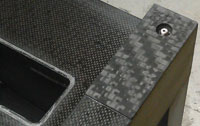
Posted to News on 23rd Nov 2016, 00:00
Use of composites opens up machine design possibilities
Advances in lightweight composite materials are not new, but their application in machine building projects deserves more serious consideration, says Ian Jones of KW Special Projects.

When it comes to machine building, the traditional material is metal – particularly aluminium that has been optimised through extrusions – which has reigned supreme for decades. Be it a production line, test rig or parts storage facility, tried and tested products from names such as Bosch or Item have always provided a simple, flexible and cost-effective solution to almost every engineering challenge.
And while this trusty ‘Meccano set’ will continue to play a huge role in machine building, a new approach to designing and building lightweight structures that can carry significant amounts of weight is emerging. Prompted by innovative thinking by design engineers, new approaches to industrial machine building can create solutions that were previously never considered.
A project in the wallcoverings and fabrics market shows how an unconventional approach to problem solving can overcome engineering challenges that we never previously thought possible. The client had designed a ground-breaking industrial inkjet printer that could digitally print onto several substrates and materials. Fine in principle, but in practice, it became evident to the in-house engineering team that the print head carrier was going to weigh over 800kg if designed and manufactured using conventional materials. This was a real concern, having implications for the efficiency, power and overall cost of the project.
Measuring approximately 1x2m, the print carriage – which housed over 100 print heads, ink systems, electronics and plumbing – had to be stiff, move within the global motion system and repeatedly maintain accuracy for the internally mounted print heads of 0.1mm to the print surface. It also had to cope with temperature changes of the factory conditions of up to 25°C.
While a conventional aluminium structure was central to the in-house design team’s solution, they soon realised increasing weight, print accuracy and machine servicing were challenges that needed a totally new approach. With experience in light weighting, CFD analysis and problem solving, gained though long experience in motorsport, KW Special Projects was asked to consider a fresh approach to this project. Analysing the key project requirements, three key areas were focused upon:
- Structural mounting and accurate adjustment for the print heads.
- Accessibility and serviceability
- Weight and scale
Having considered these challenges, as well as the cost of manufacture, the KWSP team proposed a radically different construction for the inkjet printer; producing a lightweight carbon fibre monocoque structure instead of traditional machined aluminium. Firstly the schematic was developed of the concept in CAD. This involved finite element analysis to predict and optimise the properties of the proposed structure and its overall mass. The team then concentrated on the challenge of mounting the print heads – and how they could be adjusted accurately in relation to each other.
One of the challenges was the vertical rigidity of the mounting plate for the print heads. It was a challenge to make the structure stiff enough to maintain the maximum 0.1mm of vertical displacement allowed, without the use of vertical support. To solve this, KWSP took inspiration from a suspension bridge and came up with the concept of placing the heads on a largely unsupported, but structural plate. This had mountings at each end and was held up by vertical suspension elements from an overhead beam.
To give maximum accessibility to print heads, KWSP devised a completely new way of supporting them, by moving the structural elements away from the areas that needed access, thus solving the problem.
Having developed the structure in CAD, a proof of concept model was then built to validate the carbon fibre construction. The prototype was used to validate the manufacturing capability and head mounting system. This approach maximised access to the print heads, therefore lowering the cost of maintenance. The use of a moulded, carbon fibre structure allowed cable and pipe runs to be integrated into the design, which dispensed with the need for additional brackets and components, maximising integration by design and reducing parts count and cost.
While KWSP’s knowledge in lightweight structural engineering delivered a solution to the challenge of weight and accessibility, it also incorporated a closed cooling system, plumbing and wiring ducting. As a result of its carbon composite structure, it had a near zero coefficient of thermal expansion.
During functional development of the integrated industrial digital printing machine, some issues were identified with ventilation and extraction of fumes around the print heads. Using CFD, KWSP modelled the air flows, the particulate and fume migration, heat rejection and convection flows in the print head carriage. CFD analysis is more often used in the fields of motorsport, aerospace and high performance sports, areas in which KWSP has previous experience, but demonstrates how technology developed for motorsport technology can be equally useful to solve industrial scale problems.
While the in-depth CFD analysis enabled the delivery of stable and consistent print heads, the adoption of carbon fibre resulted in a lightweight structure that also negated the unwanted impact of thermal expansion. The decision to use an alternative material to aluminium reduced the cost and weight of the machine. While the original structure was approaching a mass of 800kg, the final carbon composite assembly came in at under 140kg.
This project is a good example of new thinking in the area of machine building. It also demonstrates the tangible benefits of technology transfer. Increasingly referred to as ‘horizontal innovation’, sharing of knowledge and technology between sectors is a significant and untapped source of innovation within UK manufacturing.








